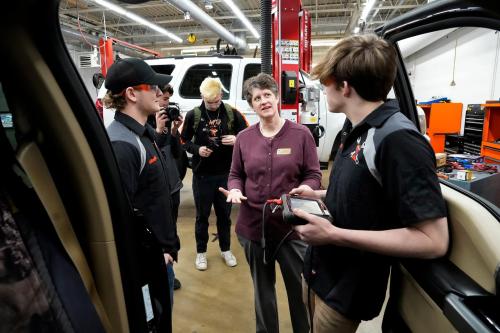With President Obama’s new budget proposal calling for moderately large increases in energy research, there have been debates flaring up on this blog and elsewhere about whether the world will need radical scientific breakthroughs—and soon—to be able to slash greenhouse-gas emissions 80 percent by mid-century and avoid the most unacceptable impacts of climate change. On the one hand, Joe Romm, a former Clinton administration official who now blogs at Climate Progress, argues that we can make do by scaling up largely existing technologies. By contrast, a recent Energy Department task force report insisted that the nation needs a lot more than incremental advances if we want to move quickly away from fossil fuels—which means pouring a lot more money into basic scientific research.
So who’s right? Both camps are. We need to invest heavily in incremental developments so that we can deploy existing green technology quickly and we need to invest in basic scientific research and shoot for big, revolutionary advances. In any case, a clean-tech future won’t come without a huge increase in direct spending on federal R&D. But here’s the problem: The federal government’s current system for conducting energy research isn’t really capable of handling either task. As a new report issued by my group at the Brookings Institution recently concluded, federal energy R&D efforts have a number of major shortcomings.
First of all, those research efforts are grossly underfunded. Last year, the federal government spent less than $2.5 billion on non-defense, technology-related R&D—at a time when some innovation experts are calling for investments on the order of $20 billion to $30 billion per year. In fact, that $2.5 billion was less than one-quarter of what was spent in real terms back in 1978, a reminder of how grossly we’ve slacked off.
Equally disturbing, though, is the fact that the basic structure of U.S. energy research remains flawed. For starters, energy-innovation research isn’t even the Energy Department’s primary pursuit right now—the department’s budget and attention is far more tied up with managing (and cleaning up after) the country’s sprawling nuclear-weapons system. What energy-research efforts do exist within DOE, meanwhile, remain fragmented and insular. Currently, for example, the department’s R&D offices and programs are segmented and focus on discrete fuel sources (e.g. coal, oil, gas, nuclear, and renewables) rather than cooperating on a broad, multidisciplinary approach to the nation’s energy problems. And the DOE’s labs are still dominated by a national-security mindset—a consequence of their past (and present) weapons work. As a result, the bulk of DOE’s research remains too isolated from the marketplace to produce and commercialize practical clean-energy innovations in short order.
What’s the alternative? It goes without saying that the nation should hike federal investments in energy R&D—which the Obama administration seems committed to doing in its recent budget outline. But the dysfunctional nature of the existing energy-research system requires not just money but reinvention. And that’s why we propose that Congress and the Obama administration start to transform the way the nation conducts energy R&D by creating a diverse array of energy discovery-innovation institutes (e-DIIs)—high-powered, multidisciplinary, applications-oriented innovation centers.
E-DIIs—which would vary in size and theme—would be located in the nation’s major metropolitan areas and bring about intense collaboration on various energy topics between local universities, national labs, private companies, venture capitalists, and local governments. The institutes would link basic scientific research with the sort of more practical focus that AT&T’s Bell Labs employed to develop the transistor in the 1940s. The centers—with a strict mandate to produce or die—would focus on the early end of technology development, but also keep an eye on the medium term, too. In that sense, they would help transcend the false opposition between pure science and applied technology and give us a fighting chance at reorienting the nation’s energy system in the short amount of time we have.



Commentary
Op-edFederal Energy R&D: Do It All – But Differently
March 10, 2009